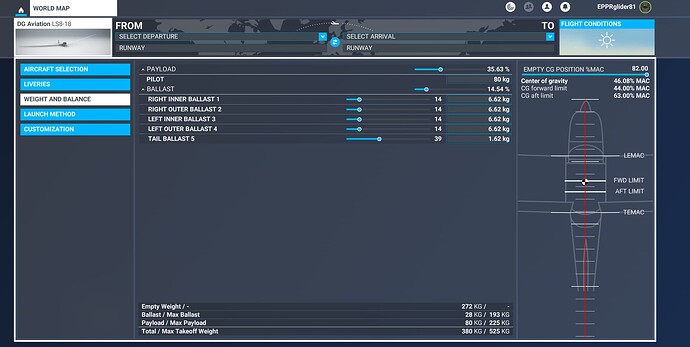![]() Thank you for using the Bug section, using templates provided will greatly help the team reproducing the issue and ease the process of fixing it.
Thank you for using the Bug section, using templates provided will greatly help the team reproducing the issue and ease the process of fixing it.
2 tags are required: One for platform, and one for aircraft.
Are you using Developer Mode or made changes in it?
No
Have you disabled/removed all your mods and addons? If the issue still occurs with no mods and add-ons, please continue to report your issue. If not, please move this post to the Community Support section.
No mods in community folder
Which aircraft are you reporting an issue about? (Please also add the proper tag for it)
Glider Asobo Ls8-18
Brief description of the issue:
Maximum glide ratio (GR) and glide polar of Asobo’s ls8-18 as measured in the MSFS 2020 are fundamentally incorrect in relation to data provided in real life ls8-18 flight manual. Maximum GR as measured in sim is about 37 @ 137km/h for 380kg (33km/m2 wing loading) while from real Ls8-18 manual chart can be read max GR 47@92km/h. Moreover Glide Ratio versus speed graph is hugely different - that is in speed range 80-130km/h (which is also most often used range) there is huge discrepancy between simulated and real glide ratio!
At 380kg mass as read from the following chart:
At speed 80km/h Glide Ratio should be around 42 and as measured in MSFS is around 20
At speed 90km/h Glide Ratio should be around 47 and as measured in MSFS is around 25
At speed 100km/h Glide Ratio should be around 46 and as measured in MSFS is around 30
At speed 110km/h Glide Ratio should be around 45 and as measured in MSFS is around 35
At speed 120km/h Glide Ratio should be 42 and as measured in MSFS is 35.
Please also note that greater mass should shift glide polar to the right (as shown in RL manual chart).
Provide Screenshot(s)/video(s) of the issue encountered:
Here is an official chart form Ls8-18 manual (can be read for example here: from on page 5-4) :
With green I marked Glide Ratio plot of Ls8-18 version with 33kg/m2 wing loading which corresponds to 380kg total glider mass.
Detailed steps to reproduce the issue encountered:
Here are weight settings (note that it was not possible to set 380Kg weight without ballast which is also incorrect in relation to real flight manual - as 380kg chart corresponds to no water balast and in the sim it resulted out of bounds center of gravity):
When taking measurements it is of highest importance to test it in no thermals or other updtrafts, only still air weather setting (testing in normal weather would be hugely affected by random updrafts) - so no wind preset was used, flying over ocean in december at dusk:
Test was performed by slewing to around 1500m AMSL, flying perfectly straight for some time with stabilised speed (it is of highest importance not to do any yoke/rudder movements and have stable speed as at such GR even slightest change can distort measurements!), changing heading and repeating test at different speed and so on at several speeds. Then another test was performed at another location always over ocean. All time external tool (freely available SimFlightPath) using SimConnect interface was used to record those flights in GPX format, then those GPX were loaded to B21 Task Planner where parts with constant speed were marked and tool provided calculated Glide Ratio for marked range, example shows “GLIDE 30:1” for speed 97kph:
Of course longer straight flights would provide even more precise data, but discrepancy in repeated tests from real life data is already so huge it is no point to measure it in more detail.
Glide ratio at given speed is so fundamental property of given glider type that there is no point in stating that you model Ls8-18 when it is so far off currently.
RL glider racing pilots can exploit even 2-3 point difference at some speed to win the competition and now at some speeds we have huge 20 points gap!
Current characteristic resembles more wooden gliders of 70’s era.
Please put great effort in modelling correct glide polar at all speed range and if it is impossible replicate RL glider polar in current flight model please improve it for MSFS2024.
PC specs and/or peripheral set up if relevant:
Does not matter - RTX3080TI, 32Gb Ram, AMD Ryzen 5 3600, Win10
Build Version # when you first started experiencing this issue:
Does not matter but tested in 1.33.8.0
![]() For anyone who wants to contribute on this issue, Click on the button below to use this template:
For anyone who wants to contribute on this issue, Click on the button below to use this template:
Do you have the same issue if you follow the OP’s steps to reproduce it?
Provide extra information to complete the original description of the issue:
If relevant, provide additional screenshots/video:







